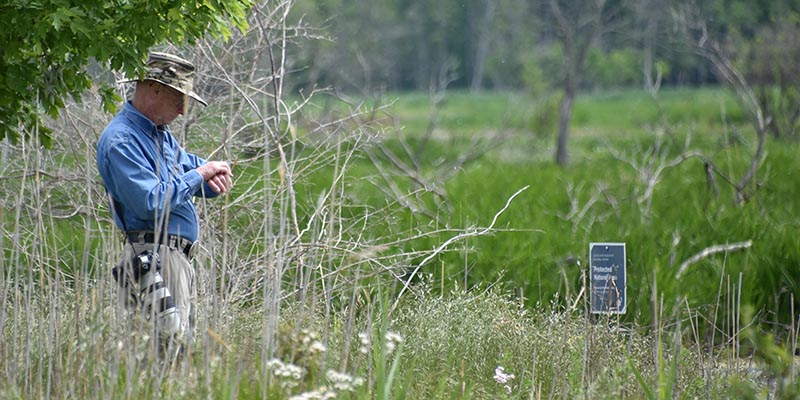
The Mentor Marsh is one of Ohio’s most important ecologic jewels. Located on the shores of Lake Erie approximately 25-minutes from downtown Cleveland, this natural haven teems with wildlife year-round…but this hasn’t always been the case. As little as a decade ago, the marsh was a near-ecological desert. What was once a densely forested wetland was all but destroyed in the 1960s when salt tailings from a nearby mine were dumped into the marsh basin. Over the years, native species died off or were choked out by a steadily growing, solid stand of invasive phragmites, or common reed grass.
But, ambitious restoration efforts led by the Cleveland Museum of Natural History and a coalition of government and agency partners including the City of Mentor has resulted in an explosive rebound in native species. Today, the phragmites has all but been eradicated and a diverse assortment of flora and fauna have reclaimed their standing in the marsh.
Today, the restored landscape better supports migratory bird species as they continue their journey to their breeding grounds. In fact, as many as 260 unique bird species have recently been documented in and around the marsh basin.
Local and regional birders have enjoyed the ever-growing visual bounty over the past decade and now word has started to make its way to enthusiasts from coast-to-coast with visitors stopping by from as far away as Oregon and Maine.
Peak spring migration is about to start, and the Mentor Marsh will be soon be brimming with activity. We caught up with Mentor Natural Resources Specialist and avid birder, Joel Throckmorton, who shared some tips on how visitors can make the most of their experience.
Q: When is the peak spring migration here in Mentor?
A: Generally speaking, spring migration starts in early April for most species and winds down towards the end of May. Peak migration for most neotropical species coming from Central/South America should occur from around May 5th through May 22nd, and then taper off.
Q: What species can we expect to see?
A: Man, this is tough. It depends what your target birds are or what you are hoping to see. For many birders, the targets are new world “wood warblers,” also called gems of the forest due to their stunning colors. There are just over 30 species you can see in this part of the country. Many people also conduct migratory “lake watches” from an onshore vantage point. On spring days, with warm temperatures (>50°) and strong winds out of the south, birds will move in huge numbers and push across Lake Erie. It’s not uncommon on these days in mid-late April to see hundreds of turkey vultures and hawks fly north.
Q: What are some rare species which have been spotted?
A: The Mentor Marsh region has produced some awesome rarities in recent years. Birders will come from hundreds of miles sometimes for the rare find. Several years ago, birders found a yellow rail – an incredibly secretive marsh bird – on the Wake Robin Boardwalk. The Mentor Lagoons Nature Preserve hosted the first Ohio record of tropical kingbird, a bird that resides in Central America. Other rare birds that continue to be spotted almost yearly in the marsh include little blue heron, snowy egret, and sandhill cranes.
Q: What’s the best timeframe/window to see certain species?
A: If you want to focus on seeing the highest diversity of species, it’s best to look at the active radar from mid-April through late May. Many people don’t realize that most passerines migrate at night. About an hour after sunset, you can see huge movements of birds taking off across the U.S. on the birdcast.info active radar loop. If you notice this in Ohio, its best to get to your favorite hotspot the next morning around sunrise. Birding usually slows down around 11:00 AM but can pick up again in the evening hours.
Q: What are good viewing locations in and around Mentor?
A: The best place to look for migratory shorebirds has to be Headlands Dunes State Nature Preserve, due to the expansive beach. The woods can also be filled with nice warblers and vireos. The Northeast end of the Zimmerman Trail by Shipman Pond is also very productive. The Mentor Lagoons Nature Preserve is a great place to see both marsh birds and ducks, but also woodpeckers and warblers within the deciduous forest. The best spot for a morning ‘lakewatch’ is at the emergent tower at Lake Erie Bluffs. Later in the day, that high vantage point can also give you great looks at migratory hawks. A number of other hotspots exist in the immediate area.
Those heading into town will be surprised at the number of nearby amenities including shopping, dining, lodging, and local attractions. Visitors are invited to make the most of their day by stopping by the James A. Garfield National Historic Site, Holden Arboretum, and other local sites. For a complete list of where to eat, shop, play and stay in the City of Mentor, visit www.visitmentor.com. The Lake County Visitor’s Bureau is also a great resource for things to see and do in Lake County.
The City of Mentor Natural Resources Division is dedicated to the preservation, conservation, study and management of the city’s natural areas. They can be reached at (440) 974-5717. Learn more at www.mentornature.com or follow them on Facebook.
